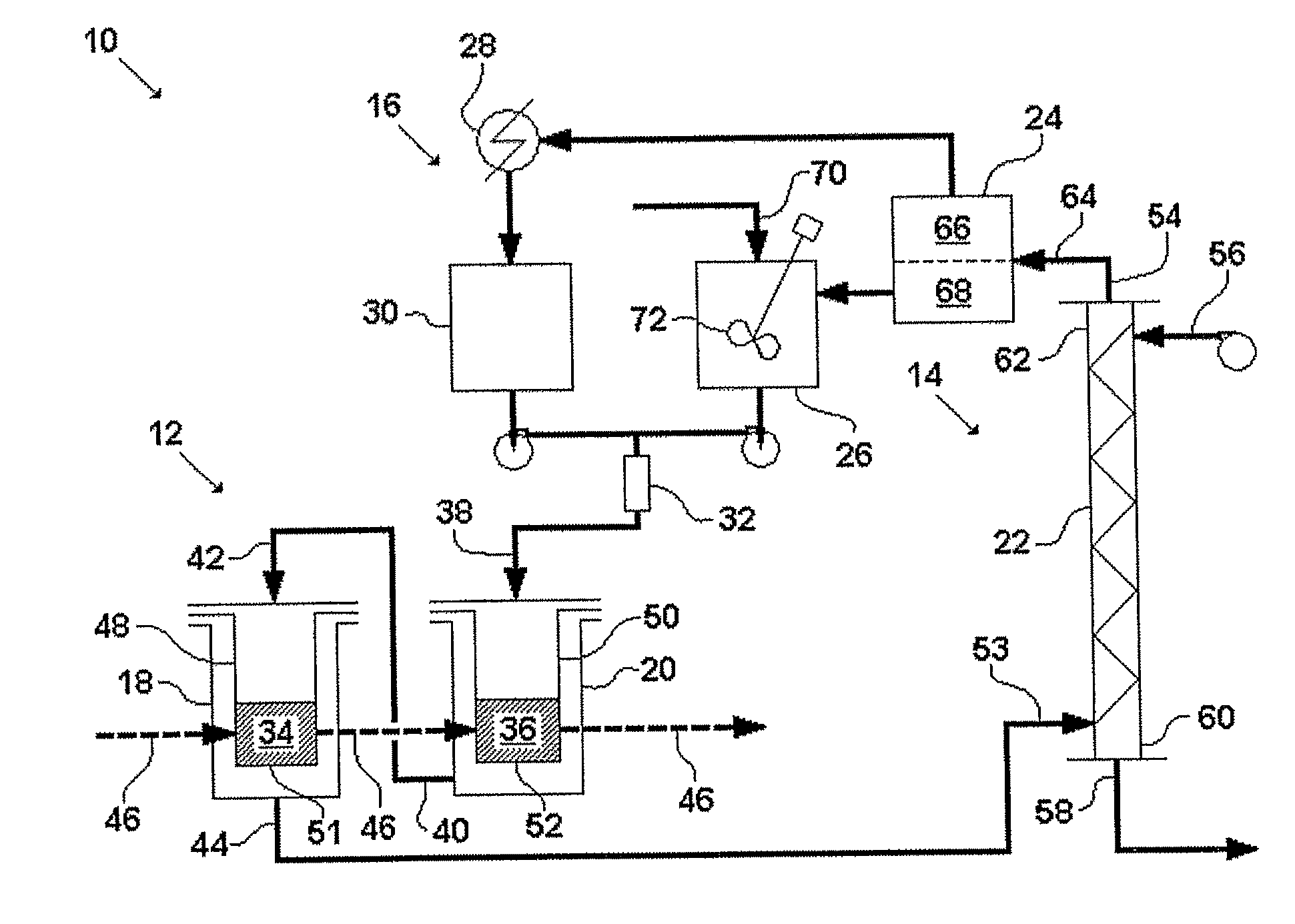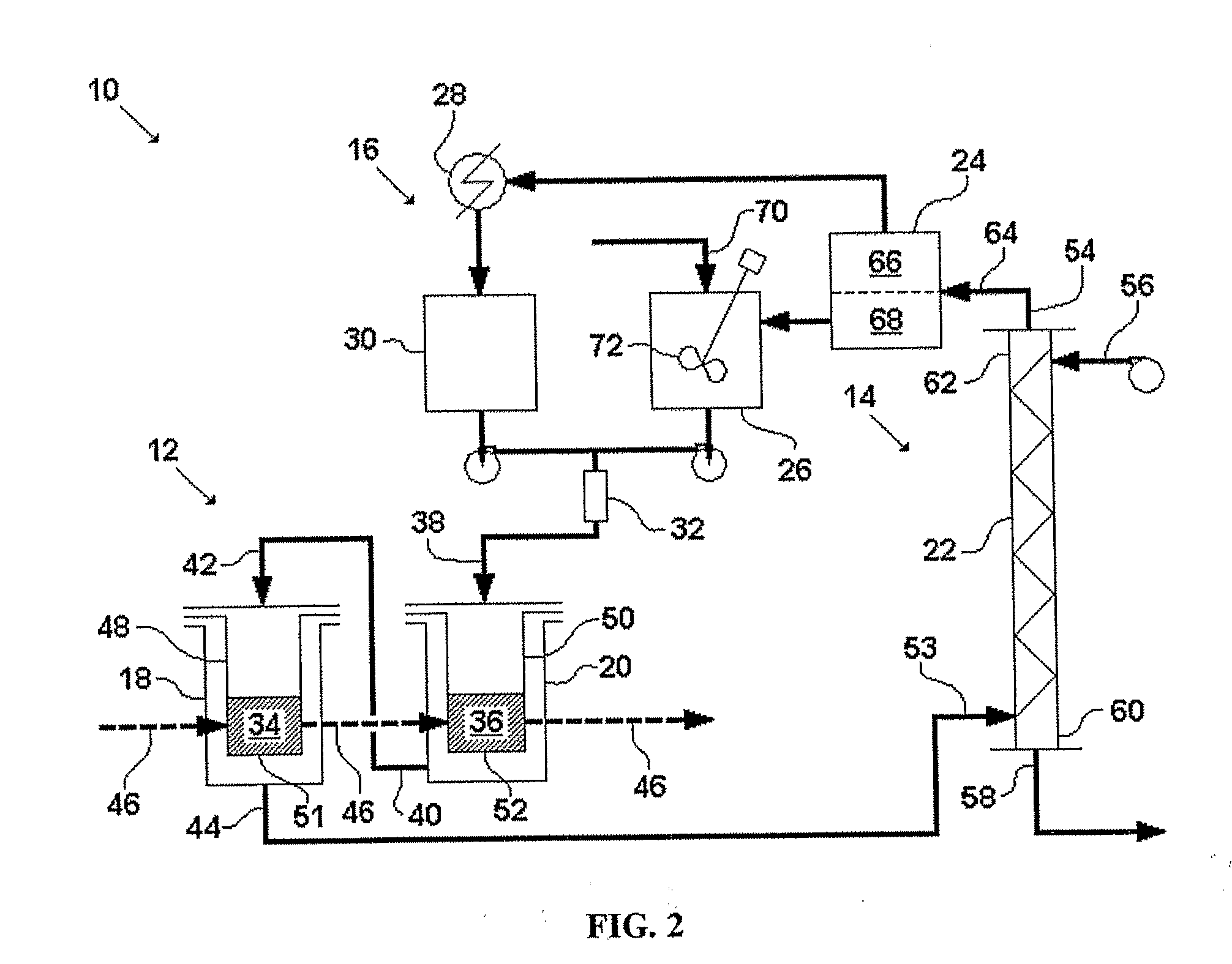Method and System for Recovering Metal from Metal-Containing Materials
a metal and metal-containing technology, applied in the field of metal recovery methods and systems, can solve the problems of increasing process costs, purex process, cost and waste generation, etc., and achieve the effect of facilitating the separation of different metals and facilitating the movement of batches
- Summary
- Abstract
- Description
- Claims
- Application Information
AI Technical Summary
Benefits of technology
Problems solved by technology
Method used
Image
Examples
example 1
[0123]This example describes several laboratory trials that were performed to study the effect of process conditions on the mass transfer of the metal in the stripping step. In these trials, the metal was uranium, the complexing agent was TBP, the oxidizing agent was nitric acid and the stripping agent was water. Tables 3-7 show the concentrations of uranium and nitric acid before stripping as well as the concentrations of uranium and nitric acid in the organic and aqueous phases after stripping. Each table shows the results of one or more trials performed at a given temperature, pressure and ratio of TBP to water. Two values for each of these variables were tested, with each table showing the data for trials performed at a different combination of values. Comparing the data between the tables indicates the effect of each variable on the mass transfer. Within each table, the individual trials represent different starting concentrations of uranium and nitric acid.
TABLE 3Stripping Dat...
example 2
[0125]This example describes one embodiment of the disclosed system. FIGS. 5-8 illustrate this embodiment in detail. FIG. 5 is a simplified schematic of the system. FIGS. 6A and 6B are a plan view and a schematic illustration of the system, respectively, with piping detail. FIGS. 7A and 7B are a plan view and a schematic illustration of the system, respectively, with dimension detail. FIG. 8 is a piping and instrumentation diagram for the system. The following abbreviations are used in the labels for certain elements in FIGS. 6-8: level control valve (LCV), pressure control valve (PCV), pump (P), safety valve (SV), and tank (TK). The labels for the remaining elements of the system are coded as shown in Table 8.
TABLE 8Key to Labels in FIGS. 6-8First LetterPpressureLlevelTtemperatureFflowHoutputSecond LetterIindicatorTtransmitterEelementSswitchYsignal converterThird LetterCcontrollerHhighLlow
[0126]A TBP-HNO3-water solution of the form TBP.(HNO3)1.8.(H2O)0.6 will be made up in TK-2 usi...
example 3
[0136]This example provides a comparison of uranium recovery by one embodiment of the disclosed process and uranium recovery by the PUREX process. Table 14 shows the initial concentration of nitric acid in the aqueous phase, the final concentration of uranium in the aqueous phase and the distribution ratio achieved in four trials modeling one embodiment of the disclosed process. The distribution ratios are equal to the concentration of uranium in the organic phase by weight divided by the concentration of uranium in the aqueous phase by weight. For the trials shown in Table 14, the uranium was extracted in supercritical carbon dioxide at 200 bar and 50° C. The ratio of TBP to water in the stripping step was 1.0.
TABLE 14Uranium Recovery with TBP in Supercritical CO2Initial ConcentrationFinal Concentration ofof HNO3 in theUranium in theDistributionTrialAqueous Phase (M)Aqueous Phase (M)RatioTrial 11.20.421Trial 24.80.115.9Trial 36.70.0669.2Trial 41.90.152.2
[0137]Table 15 shows the ini...
PUM
| Property | Measurement | Unit |
|---|---|---|
| internal pressures | aaaaa | aaaaa |
| internal pressures | aaaaa | aaaaa |
| internal pressures | aaaaa | aaaaa |
Abstract
Description
Claims
Application Information
 Login to View More
Login to View More - R&D
- Intellectual Property
- Life Sciences
- Materials
- Tech Scout
- Unparalleled Data Quality
- Higher Quality Content
- 60% Fewer Hallucinations
Browse by: Latest US Patents, China's latest patents, Technical Efficacy Thesaurus, Application Domain, Technology Topic, Popular Technical Reports.
© 2025 PatSnap. All rights reserved.Legal|Privacy policy|Modern Slavery Act Transparency Statement|Sitemap|About US| Contact US: help@patsnap.com



